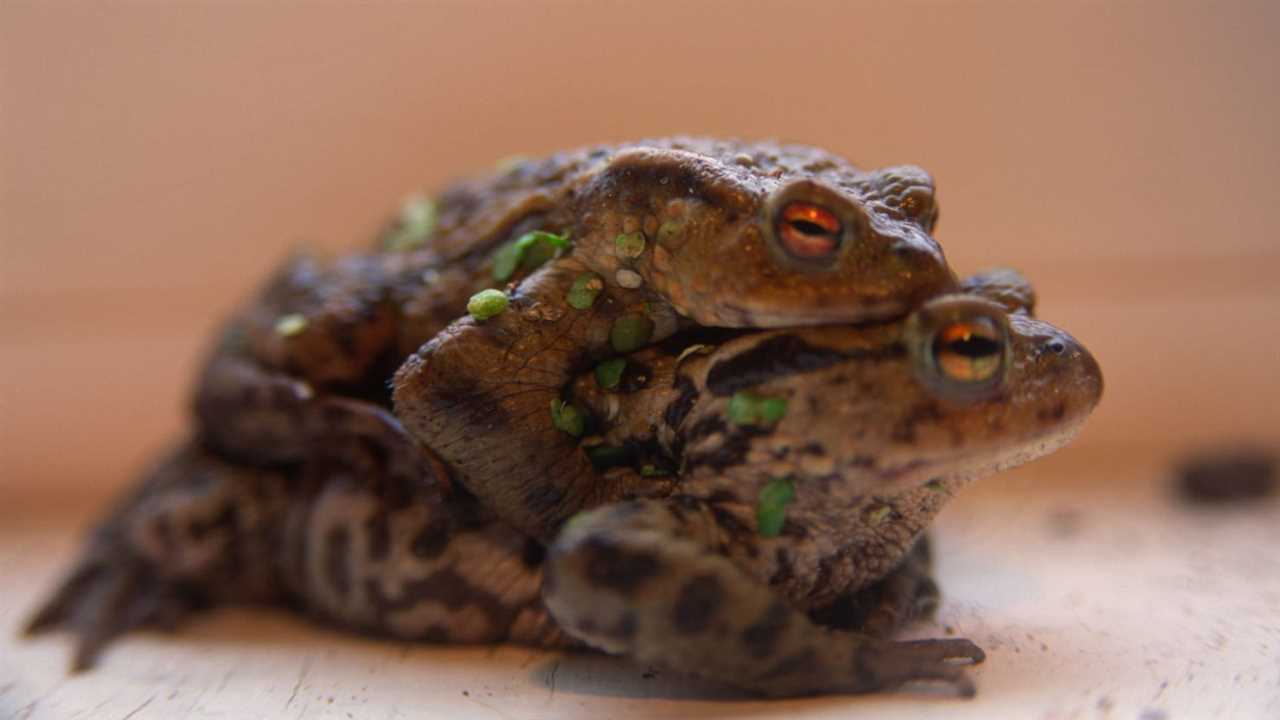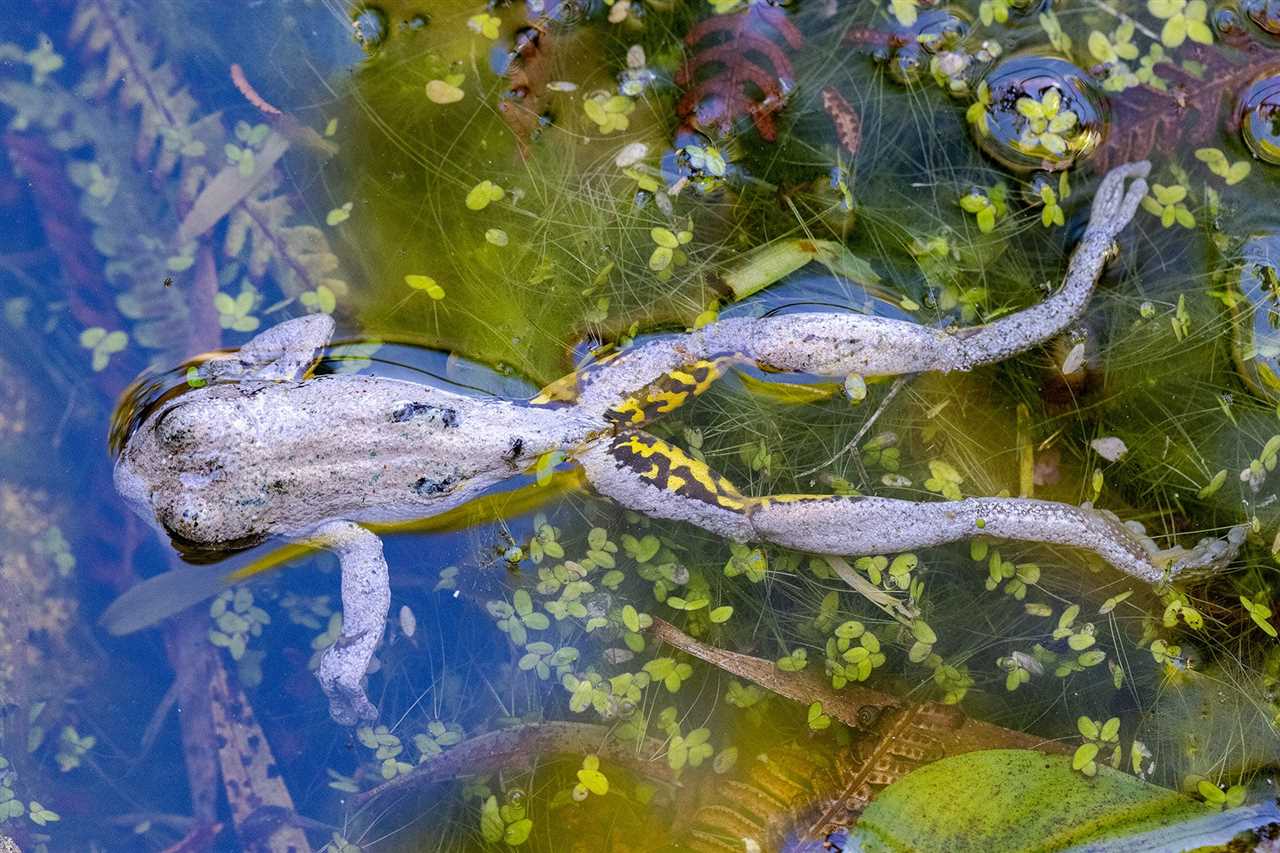One possible reason behind post-mortem movements in frogs is the muscle contractions that occur after death. When a frog dies, its muscles can continue to contract due to the build-up of lactic acid. This can make the frog’s limbs twitch or move, giving the appearance that it is still alive. These muscle contractions can be quite strong and can even cause the frog to jump or kick.
Another theory suggests that the movements in frogs after death could be a result of nerve activity. Even after an amphibian has died, its nerve cells can still transmit electrical signals. These signals can cause the muscles to contract and produce movements in the frog’s limbs. The nerve cells may continue to fire for a short period of time after death, which could explain why the frog continues to move.
Frog Anatomy: Why do frogs move after death?
Frogs, like many other animals, have a complex anatomy that allows them to perform various functions during their lifetime. This includes their ability to move, jump, and catch prey. However, it is interesting to note that even after death, frogs may exhibit certain movements. This phenomenon has intrigued scientists for many years and has led to numerous studies and research to understand the reasons behind post-mortem movements in frogs.
When a frog dies, its muscles and nerves stop receiving signals from the brain and spinal cord. This results in the cessation of voluntary movement. However, other factors come into play that may cause the frog’s body to exhibit involuntary movements.
Additionally, the frog’s nervous system may also play a role in post-mortem movements. Nerve cells, or neurons, are responsible for transmitting electrical signals throughout the body. Even after death, these neurons can still fire sporadically, causing muscles to contract and move. This phenomenon is similar to how certain reflexes can still occur in decapitated animals.
It is also important to consider the process of rigor mortis in frogs and how it may influence post-mortem movements. Rigor mortis is the stiffening of the muscles that occurs after death due to the depletion of ATP and the buildup of lactic acid. During this process, the frog’s body becomes rigid, making movements difficult. However, as rigor mortis wears off, the body may become more flexible, potentially allowing for post-mortem movements.
Why do frogs move after death?
After the death of a frog, it is not uncommon to observe post-mortem movements in their body. These movements can be quite puzzling, as one might wonder why a lifeless creature would exhibit any form of motion. However, there are several reasons behind these post-mortem movements in frogs.
Internal Organ Regulation: One of the main factors contributing to post-mortem movements in frogs is the regulation of their internal organs. Even after death, certain muscles and nerves may continue to contract and relax due to residual electrical signals in the central nervous system. This can result in involuntary movements such as twitching or limb extension.
Neuromuscular System: Frogs have a complex neuromuscular system that consists of nerves, muscles, and synapses. Even in death, these interconnected systems may still have residual energy that can trigger sporadic movements. This is especially true in the immediate aftermath of death when energy reserves within the body are still present.
Enzyme Activity: Enzyme activity can also play a role in post-mortem movements in frogs. Some enzymes, such as ATPase, continue to function and break down ATP (adenosine triphosphate) even after death. This breakdown of ATP can generate energy and cause the muscles to contract and relax, leading to post-mortem movements.
Decomposition Process: As a frog’s body begins to decompose, gases are produced, which can create pressure within the body. This pressure can cause the limbs or other body parts to move due to the release of built-up gases.
Environmental Factors: Environmental factors such as temperature and humidity can also contribute to post-mortem movements in frogs. Changes in temperature can affect the rate of decomposition and the production of gases, while humidity can influence the movement of gases within the body, leading to post-mortem movements.
Neuromuscular System: How and Why Frogs Move After Death

The neuromuscular system is responsible for the coordination of muscle movement in frogs. It is composed of the nervous system, which includes the brain and spinal cord, and the muscles themselves. During the lifetime of a frog, the brain sends electrical signals, called action potentials, to the muscles, instructing them to move. These action potentials are generated by the firing of neurons in the brain.
However, even after death, the neurons in a frog’s brain may still be capable of producing action potentials. This is due to the accumulation of ions, such as calcium, in the neurons. Calcium ions are essential for the generation of action potentials, and their presence can cause the neurons to fire even in the absence of oxygen and other metabolic processes.
When the neurons in a frog’s brain continue to fire after death, they send electrical signals to the muscles, instructing them to contract. The muscles, still capable of responding to these signals, contract and cause the observed post-mortem movements. These movements may include twitching of the limbs, jerking of the body, or even hopping-like motions.
| Why do frogs move after death? |
|---|
Why Do Frogs Move After Death?
One possible explanation for post-mortem movements in frogs is rigor mortis. Rigor mortis is a natural biological process that occurs after death and causes the muscles in the body to become stiff and rigid. This stiffness can sometimes lead to involuntary muscle contractions, which may be responsible for the observed movements in frogs.
Another factor that could contribute to post-mortem movements in frogs is enzyme activity. Enzymes are chemical substances produced by living organisms that facilitate various biochemical reactions in the body. Even after death, some enzymes may still be active in the frog’s body, causing chemical reactions that could result in movements.
Environmental factors may also influence post-mortem movements in frogs. Temperature, humidity, and other external conditions could affect the decomposition process and the rate at which gases and fluids are released. These factors could potentially impact the movements observed in dead frogs.
While the exact reasons behind post-mortem movements in frogs are still not fully understood, it is clear that both biological and environmental factors play a significant role. Further research and studies are needed to unravel the mechanisms behind these intriguing phenomena.
Reasons Behind Post-Mortem Movements in Frogs
Internal Organ Regulation
One reason why frogs may exhibit post-mortem movements is due to the regulation of their internal organs. Even after death, certain biological feedback mechanisms may still be active, causing muscles to contract and relax.
Rigor Mortis
Another factor that contributes to post-mortem movements in frogs is rigor mortis. Rigor mortis is a stiffening of the muscles that occurs after death. This stiffening can cause the limbs of the frog to move, giving the appearance of post-mortem movement.
Enzyme Activity
Enzyme activity can also play a role in post-mortem movements in frogs. Certain enzymes may continue to function after death, leading to the release of chemicals that can cause muscle contractions.
Decomposition Process
Environmental Factors
Various environmental factors can also contribute to post-mortem movements in frogs. Changes in temperature, humidity, and air pressure can all affect the rate of decomposition and the likelihood of movement.
Biological Factors
The specific biological makeup of each frog can also influence post-mortem movements. Factors such as age, overall health, and genetic predispositions can all play a role in determining whether or not post-mortem movements occur.
Post-mortem Movement Theories
Scientists have developed several theories to explain post-mortem movements in frogs. Some suggest that the movements are simply the result of residual muscle activity, while others propose that they are a form of reflex or automatic response.
Research and Studies
Application in Forensic Science
Decomposition Process in Frogs
After death, frogs undergo various post-mortem movements and changes. One of the significant processes that occur after death is decomposition. Decomposition refers to the breakdown of organic matter by bacteria, fungi, and other microorganisms, which results in the release of gases and the breakdown of bodily tissues.
During the decomposition process, several stages can be observed. These stages include fresh, bloat, active decay, advanced decay, and dry remains. Each stage is characterized by specific changes in the appearance, smell, and composition of the frog’s body.
Factors Affecting the Decomposition Process
There are several factors that influence the rate and progression of decomposition in frogs:
- Environmental factors: Temperature, humidity, and exposure to sunlight can impact the speed at which decomposition occurs. Warmer temperatures accelerate the decomposition process, while cooler temperatures slow it down.
- Biological factors: The presence of insects, scavengers, and other organisms can affect the decomposition process. These organisms can feed on the frog’s body, accelerating the breakdown of tissues.
- Biological feedback mechanisms: The body’s own enzymes and microorganisms play a role in the decomposition process. Enzyme activity and the release of gases by bacteria contribute to the breakdown of organic matter.
Over time, the frog’s tissues break down, and the body undergoes liquefaction. Eventually, only the skeletal remains, skin, and some dried tissues are left. This process usually takes a few weeks to several months, depending on the environmental conditions.
Application in Forensic Science
The study of decomposition in frogs and other organisms has significant applications in forensic science. Forensic entomologists and pathologists can use the knowledge of decomposition stages and factors to estimate the time since death in both human and animal cases. By examining the progression of decomposition and the presence of certain insects or organisms, forensic experts can provide valuable information in criminal investigations and legal proceedings.
Why do frogs move after death?
After death, it is not uncommon for frogs to exhibit post-mortem movements. These movements, although often subtle, can be puzzling to observe. To understand why frogs move after death, it is necessary to consider the interplay of various environmental and biological factors.
Environmental factors: The environment plays a significant role in the post-mortem movements of frogs. Temperature, humidity, and external stimuli such as wind or water can all affect the movement of a deceased frog. For example, changes in temperature can cause muscle contractions, leading to visible movements.
Biological factors: The biological composition of a frog’s body can also contribute to post-mortem movements. Internal gases produced during decomposition can cause muscles to contract, resulting in small twitches or jerks. Additionally, the release of stored energy in the muscles can also lead to movement.
Biological feedback mechanisms: Frogs have complex biological systems that include feedback mechanisms to regulate bodily functions. Even after death, these feedback mechanisms can continue to operate for a certain period, resulting in reflexive movements. These movements are involuntary and do not indicate any signs of life.
Research and studies: Scientists have conducted research and studies to understand the phenomenon of post-mortem movements in frogs better. By examining factors such as enzyme activity, rigor mortis, and the decomposition process, they have gained insights into the underlying mechanisms that contribute to these movements.
Biological Factors: Why Do Frogs Move After Death
After death, it is not uncommon for frogs to exhibit movements or muscle contractions. While these post-mortem movements might seem strange, they can be attributed to various biological factors.
1. Nerve Excitation:
One possible explanation for post-mortem movements in frogs is nerve excitation. Even after death, the nerve cells in a frog’s body may still be able to conduct electrical impulses. These impulses can trigger muscle contractions, causing the frog to move involuntarily.
2. Chemical Changes:
3. Biological Feedback Mechanisms:
Frogs possess biological feedback mechanisms that can continue to operate even after death. These mechanisms might include reflexive responses to certain stimuli or signals from the environment. These reflexes can cause the frog’s muscles to contract or twitch, resulting in post-mortem movements.
4. Muscle Contraction:
Frog muscles can contract due to a series of biochemical reactions that occur within the cells. Even after death, these reactions can continue in response to certain stimuli, leading to muscle contractions or movements. These contractions may also be influenced by the release of stored energy within the muscles.
5. Metabolic activity:
Although metabolic activity significantly decreases after death, some processes may still occur. These residual metabolic activities can lead to the production of energy, which can then be utilized by muscle cells to contract and cause post-mortem movements.
Biological Feedback Mechanisms: Why Do Frogs Move After Death?
After death, the physiological processes in an organism gradually cease. The lack of oxygen and energy production leads to the breakdown of cellular functions. However, certain biological feedback mechanisms can still trigger muscle contractions and movements in frogs, even after they have passed away.
One possible reason for post-mortem movements is the activity of neural circuits. The brain and spinal cord of a frog are complex structures that control various bodily functions. Even after death, some neural circuits can still receive and transmit signals, albeit in a disorganized manner. These aberrant electrical impulses can stimulate muscle fibers, causing involuntary movements.
Another factor that contributes to post-mortem frog movements is the presence of stored energy in the muscles. Just like a wound-up spring, muscles store potential energy that can be released even after the death of an organism. This stored energy can result in spasmodic contractions and twitching movements.
In addition, biochemical reactions continue to occur after death, albeit at a slower pace. Enzymes, which are responsible for catalyzing various physiological processes, can still be active in the post-mortem stage. These residual enzymatic activities can trigger muscle contractions and movements in frogs, causing them to twitch or kick.
Environmental and biological factors can also influence the occurrence of post-mortem movements in frogs. Temperature, humidity, and the presence of certain microorganisms can affect the rate of decomposition and the release of gases. The species of frog, its size, health condition, and cause of death can also impact the extent and duration of post-mortem movements.
Why do frogs move after death?
After the death of frogs, it is not uncommon for them to exhibit post-mortem movements. These movements, which can include twitching or jumping, have puzzled scientists for many years.
Research and Studies

One area of research focuses on the neuromuscular system of frogs. It is believed that the movements observed after death are a result of residual muscle contractions caused by nerve impulses. By studying the electrical activity in frog muscles, scientists have been able to gain insights into the mechanisms behind these post-mortem movements.
Another aspect of research examines the role of rigor mortis in post-mortem movements. Rigor mortis is the stiffening of the muscles that occurs after death and is caused by a lack of ATP, a molecule that provides energy for muscle contractions. Scientists have been investigating how the timing and duration of rigor mortis influence the movements observed in frogs after death.
Application in Forensic Science

Time of Death Estimation
One of the main areas where the study of post-mortem movements in frogs can be applied in forensic science is in estimating the time of death. By observing the timing and sequence of movements in frogs after death, scientists can develop a timeline of post-mortem changes and use this information to estimate the time of death in human cases.
For example, the onset and duration of rigor mortis (stiffening of the muscles after death) in frogs can provide valuable insights into the timing of events after death. By comparing these findings to human cases, forensic investigators can make more accurate estimations of the time of death.
Cause of Death Determination
Another important application of studying post-mortem movements in frogs is in determining the cause of death in forensic cases. In some instances, the presence or absence of certain movements or changes in frogs after death can indicate specific causes of death.
For example, certain movements or changes in the neuromuscular system of frogs after death may indicate poisoning or the presence of toxins. By studying these phenomena in frogs, forensic investigators can better understand similar indicators in human cases and make more accurate determinations of the cause of death.
Investigative Tool
Furthermore, the study of post-mortem movements in frogs can help scientists and forensic investigators develop new techniques and technologies for analyzing post-mortem changes in human cases. By utilizing the unique characteristics of frogs and their post-mortem movements, researchers can improve the accuracy and reliability of forensic investigations.

I’m Lena Adams—a product of an unconventional upbringing in the African wilderness. My father, a daring explorer of African wildlife, sparked my fascination with reptiles, a passion that intertwined with the tragic loss of my mother during an expedition, leaving an indelible mark on my life. Driven to understand the creatures that captivated my parents, I embarked on my journey, sharing insights about reptiles, frogs, and lizards on my website. Through my explorations and conservation efforts, I honour my family’s legacy while seeking connections—to the creatures, nature, and the mother whose presence I yearn to understand.
